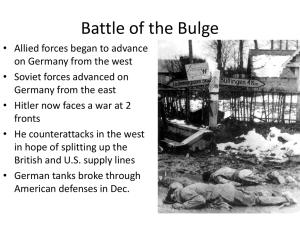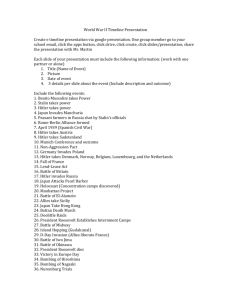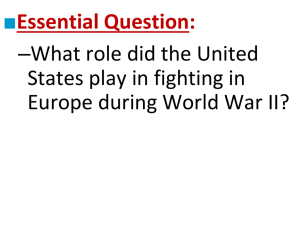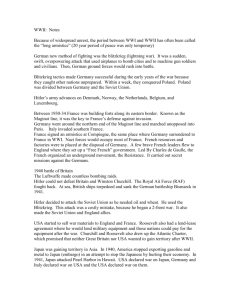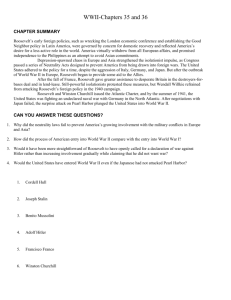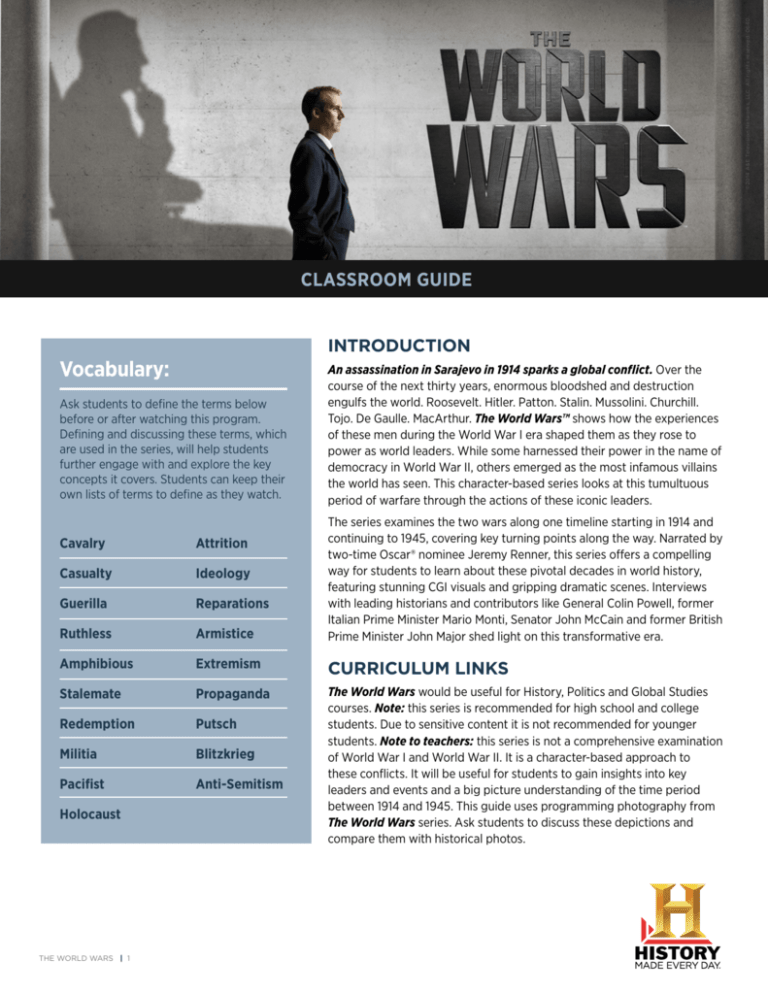
©2014 A&E Television Networks, LLC. All rights reserved. 0640.
Classroom Guide
INTRODUCTION
Vocabulary:
Ask students to define the terms below
before or after watching this program.
Defining and discussing these terms, which
are used in the series, will help students
further engage with and explore the key
concepts it covers. Students can keep their
own lists of terms to define as they watch.
An assassination in Sarajevo in 1914 sparks a global conflict. Over the
course of the next thirty years, enormous bloodshed and destruction
engulfs the world. Roosevelt. Hitler. Patton. Stalin. Mussolini. Churchill.
Tojo. De Gaulle. MacArthur. The World Wars™ shows how the experiences
of these men during the World War I era shaped them as they rose to
power as world leaders. While some harnessed their power in the name of
democracy in World War II, others emerged as the most infamous villains
the world has seen. This character-based series looks at this tumultuous
period of warfare through the actions of these iconic leaders.
The series examines the two wars along one timeline starting in 1914 and
continuing to 1945, covering key turning points along the way. Narrated by
two-time Oscar® nominee Jeremy Renner, this series offers a compelling
way for students to learn about these pivotal decades in world history,
featuring stunning CGI visuals and gripping dramatic scenes. Interviews
with leading historians and contributors like General Colin Powell, former
Italian Prime Minister Mario Monti, Senator John McCain and former British
Prime Minister John Major shed light on this transformative era.
Cavalry
Attrition
Casualty
Ideology
Guerilla
Reparations
Ruthless
Armistice
Amphibious
Extremism
Curriculum Links
Stalemate
Propaganda
Redemption
Putsch
Militia
Blitzkrieg
Pacifist
Anti-Semitism
The World Wars would be useful for History, Politics and Global Studies
courses. Note: this series is recommended for high school and college
students. Due to sensitive content it is not recommended for younger
students. Note to teachers: this series is not a comprehensive examination
of World War I and World War II. It is a character-based approach to
these conflicts. It will be useful for students to gain insights into key
leaders and events and a big picture understanding of the time period
between 1914 and 1945. This guide uses programming photography from
The World Wars series. Ask students to discuss these depictions and
compare them with historical photos.
Holocaust
THE WORLD WARS | 1
©2014 A&E Television Networks, LLC. All rights reserved. 0640.
NIGHT ONE: TRIAL BY FIRE
International conflict erupts in the wake of the assassination of Archduke Franz
Ferdinand, heir to the Austro-Hungarian empire, in June 1914. A complex web of
alliances among nations is triggered and a war of unprecedented scale breaks out a
month later. Over the course of the next four years, an entire generation is shaped
by this war. World War I eventually involves dozens of countries, introduces new
technologies of war, and leaves behind millions of casualties. George Patton, Charles De
Gaulle, Winston Churchill, Joseph Stalin, Douglas MacArthur, Benito Mussolini, Hideki
Tojo, Franklin Delanor Roosevelt and Adolph Hitler are men who come of age during
these years. In this episode viewers learn about the experiences of these men, the costs
and consequences of warfare, and the ways World War I set the stage for on-going
world conflict.
Discussion Questions
1. Which nations made up the Central Powers and the Allies during World War I?
(Create a chart of these nations to refer back to as you study WWI and WWII.)
2. What was George Patton’s innovation in the battle against Pancho Villa in Mexico?
Why was this invention such a big turning point in modern warfare?
3. What were some of the characteristics of trench warfare?
Why do you think the “stalemate” continued for so long?
4. When did the United States enter World War I? What was the significance of
the entry of the U.S. into the war?
5. What was the Gallipoli campaign and why was it so important? What role did
Churchill play and how do you think it affected his life and career?
6. What role did Russia play during World War I? How do you think Stalin was
shaped by the Russian Revolution?
7. What is a “war of attrition” and how does this phrase apply to WWI?
8. What were some of the leadership characteristics of George Patton and
Douglas MacArthur? Do you think they had characteristics common in many leaders? Discuss.
9. How did World War I finally end? What were the major outcomes of the war?
10. How do you think Hitler’s experiences in WWI shaped him as a person and a leader?
What ideological philosophies did he develop after the war?
ACTIVITY
Ask students to write an essay responding to one of the questions above.
THE WORLD WARS | 2
Primary Source Activity: The Zimmermann Telegram
One of the motivators for the U.S. to enter World War I was a secret telegram from German Foreign Minister Arthur
Zimmermann to the German Minister to Mexico. This telegram was intercepted and deciphered by the British in January 1917.
The following month, the British released the telegram to President Woodrow Wilson, and the contents were published widely
in newspapers. Americans were shocked to learn that Zimmermann had tried to convince Mexico to join Germany in the war
effort in return for U.S. territory Germany believed Mexico could seize from the U.S.
Transcript of Zimmermann
Telegram (1917)
(Decoded message text of the Zimmermann Telegram)
From 2nd from London # 5747.
“We intend to begin on the first of February unrestricted
submarine warfare. We shall endeavor in spite of this to
keep the United States of America neutral. In the event
of this not succeeding, we make Mexico a proposal
or alliance on the following basis: make war together,
make peace together, generous financial support and an
understanding on our part that Mexico is to reconquer
the lost territory in Texas, New Mexico, and Arizona.
The settlement in detail is left to you. You will inform
the President of the above most secretly as soon as the
outbreak of war with the United States of America is
certain and add the suggestion that he should, on his own
initiative, invite Japan to immediate adherence and at the
same time mediate between Japan and ourselves. Please
call the President’s attention to the fact that the ruthless
employment of our submarines now offers the prospect
of compelling England in a few months to make peace.”
Signed, ZIMMERMANN.
Citation: Zimmermann Telegram, 1917; Decimal File, 1910-1929, 862.20212/82A
(1910-1929), and Decoded Zimmermann Telegram, 1917; Decimal File, 1910-1929,
862.20212/69, General Records of the Department of State; Record Group 59;
National Archives. To view the telegram in digital format visit:
www.ourdocuments.gov/doc.php?flash=true&doc=60
Document-Based Questions
1. What does the telegram reveal about Germany’s plans regarding submarine warfare?
2. What role does Zimmermann want Mexico to play in World War I?
Do you think Mexico would have agreed to this plan if given the opportunity?
3. Why do you think the Zimmermann telegram provoked the U.S. to enter World War I?
What were some of the other factors that contributed to the U.S. declaring war against Germany in April 1917?
ACTIVITY
After analyzing the telegram as a class or in small groups, ask students to respond to question #3 in essay format.
THE WORLD WARS | 3
©2014 A&E Television Networks, LLC. All rights reserved. 0640.
NIGHT TWO: A RISING THREAT
Emboldened by his experiences in battle, Adolf Hitler mobilizes membership in the
Nazi Party and formulates his plan for a nationalist Germany to regain power. Benito
Mussolini rises to the helm in Italy, leading the National Fascist Party. Meanwhile,
Franklin Delano Roosevelt ushers the U.S. through the crisis of the Great Depression.
In Japan, the quest for expansion and international power leads to increased
militarization. Hideki Tojo rises up the ranks. Hitler becomes chancellor of Germany
in 1933 and by 1939 the world explodes into war. After forming a Nonagression
Pact with Russia, Hitler attempts to conquer Europe, with Japan and Italy as allies.
Churchill, now British Prime Minister, does his best to keep Britain from total collapse
while the U.S. weighs the consequences of entering the war.
Discussion Questions
1. Who were the Axis and Allied powers during World War II?
Create a chart of these alliances to refer back to as you study this period.
2. Why do you think Hitler was so successful in mobilizing others to follow him?
What were his main goals and how did he plan to achieve them?
3. Why did FDR choose to curb military funding during the New Deal?
Do you think this was the correct decision at the time? Discuss.
4. Why did Mussolini decide to invade Ethiopia?
How did this decision tie in with his larger plans for Italy?
5. Why do you think Stalin decided to form a pact with Hitler in August 1939?
6. What was the political strategy known as “appeasement”?
Do you think it was effective during World War II? Discuss.
7. How would you describe the differences between Prime Minister Neville Chamberlain and Winston Churchill in their approach to leadership during
the early years of World War II?
8. Why do you think Roosevelt did not push to involve the U.S. in World War II right away?
Do you think this was the right decision? Discuss.
9. What were some of the main goals of Japan in the years before and during World War II?
Who was Hideki Tojo and how did he help achieve these goals during this era?
10. This episode ends right before the bombing of Pearl Harbor. At this moment in the war,
what would you predict as the outcomes of the conflict? Discuss.
ACTIVITY
Ask students to write an essay responding to one of the questions above.
THE WORLD WARS | 4
©2014 A&E Television Networks, LLC. All rights reserved. 0640.
Primary Source Analysis: FDR’s “Four Freedoms Speech”
On January 6, 1941 President Franklin Roosevelt delivered his Annual Message to Congress which later became known as his
“Four Freedoms Speech.” In this address, Roosevelt outlined the critical importance of American support to Britain during
World War II. Below is an excerpt from his address.
President Franklin Roosevelt’s Annual Message
(Four Freedoms) to Congress (1941): Excerpt
In the future days, which we seek to make secure, we look forward to a world founded upon four essential
human freedoms.
The first is freedom of speech and expression—everywhere in the world.
The second is freedom of every person to worship God in his own way—everywhere in the world.
The third is freedom from want—which, translated into world terms, means economic understandings which
will secure to every nation a healthy peacetime life for its inhabitants—everywhere in the world.
The fourth is freedom from fear—which, translated into world terms, means a world-wide reduction of
armaments to such a point and in such a thorough fashion that no nation will be in a position to commit an act
of physical aggression against any neighbor—anywhere in the world.
That is no vision of a distant millennium. It is a definite basis for a kind of world attainable in our own time and
generation. That kind of world is the very antithesis of the so-called new order of tyranny which the dictators
seek to create with the crash of a bomb.
To that new order we oppose the greater conception—the moral order. A good society is able to face schemes
of world domination and foreign revolutions alike without fear.
Citation: Franklin D. Roosevelt Annual Message to Congress, January 6, 1941; Records of the United States Senate; SEN 77A-H1; Record Group 46; National
Archives. To view the telegram in digital format visit:
www.ourdocuments.gov/doc.php?flash=true&doc=70
Document-Based Questions
1.
2.
What are the four freedoms Roosevelt describes in this speech?
Why were these freedoms at risk at the time he delivered his speech?
Roosevelt describes the “new order of tyranny.” What do you think this phrase refers to and what does
Roosevelt see as the alternative?
3. Which of the “four freedoms” do you think are most important, and why?
ACTIVITY
After discussing question 3, have students write a short essay or response paper exploring
the “four freedoms.”
THE WORLD WARS | 5
©2014 A&E Television Networks, LLC. All rights reserved. 0640.
NIGHT THREE: NEVER SURRENDER
Shockwaves reverberate throughout the U.S. after the Japanese attack Pearl Harbor
on December 7, 1941. The U.S. officially enters the war. The Allies must stop both Japan
and Germany. Mussolini is overthrown and the Allies win a few key victories including
the Battle of Midway. Roosevelt, Churchill and Stalin meet in Tehran late in 1943 to
strategize. The Allies wrest control of Western Europe back from Hitler in June 1944
through one of the largest amphibious military assaults in history: D-Day. Patton drives
his army toward Berlin. His troops make a gruesome discovery, locating concentration
camps and revealing the horrific crimes of the Nazis. Tragically, FDR dies as the
nation’s future hangs in the balance. Harry S. Truman becomes president. After the
Allies resist his final onslaught, Hitler commits suicide and Germany exits the war. In
August 1945 Truman does the unthinkable in an effort to end the conflict—he orders
atomic bombs to be dropped on Japan. The war has finally ended. But how will the
world rebuild, and will a lasting peace be possible?
Discussion Questions
1. When and why did the United States enter World War II?
2. How would you describe the relationship between FDR and Churchill?
What were some of the important decisions they made together during
World War II?
3. Why do you think Mussolini failed to maintain power in Italy?
4. What do you think were Stalin’s major goals during World War II?
How did he work with Roosevelt and Churchill to achieve these goals?
5. Why was the D-Day plan so risky?
Why do you think the Allies were able to achieve success?
6. Patton is remembered as one of the greatest generals in U.S. history.
Based on what you learned in this episode, do you agree with this assessment
of Patton? Discuss.
7. What was Hitler’s “Final Solution”? What role did the Germany military and citizenry play in
helping achieve this plan? When and how was it thwarted?
8. What was the state of the world at the end of World War II? What plans were put in place
to help rebuild?
9. At the end of this episode, the war has ended but peace is not a given. Imagine you do not
know what happened after 1945. Would you predict that peace was possible? Discuss.
THE WORLD WARS | 6
Primary Source: Transcript of Joint Address to Congress
Leading to a Declaration of War Against Japan (1941) (Excerpt)
In this speech to Congress, delivered the day after the Pearl Harbor bombing, President Roosevelt describes the attack and asks
for a declaration of war against Japan.
Mr. Vice President, and Mr. Speaker, and Members of the Senate and House of Representatives:
Yesterday, December 7, 1941—a date which will live in infamy—the United States of America was suddenly and deliberately
attacked by naval and air forces of the Empire of Japan.
The United States was at peace with that Nation and, at the solicitation of Japan, was still in conversation with its Government
and its Emperor looking toward the maintenance of peace in the Pacific. Indeed, one hour after Japanese air squadrons had
commenced bombing in the American Island of Oahu, the Japanese Ambassador to the United States and his colleague
delivered to our Secretary of State a formal reply to a recent American message. And while this reply stated that it seemed
useless to continue the existing diplomatic negotiations, it contained no threat or hint of war or of armed attack.
It will be recorded that the distance of Hawaii from Japan makes it obvious that the attack was deliberately planned many days
or even weeks ago. During the intervening time the Japanese Government has deliberately sought to deceive the United States
by false statements and expressions of hope for continued peace.
The attack yesterday on the Hawaiian Islands has caused severe damage to American naval and military forces. I regret to tell
you that very many American lives have been lost. In addition American ships have been reported torpedoed on the high seas
between San Francisco and Honolulu.
Yesterday the Japanese Government also launched an attack against Malaya.
Last night Japanese forces attacked Hong Kong.
Last night Japanese forces attacked Guam.
Last night Japanese forces attacked the Philippine Islands.
Last night the Japanese attacked Wake Island. And this morning the Japanese attacked Midway Island.
Japan has, therefore, undertaken a surprise offensive extending throughout the Pacific area. The facts of yesterday and today
speak for themselves. The people of the United States have already formed their opinions and well understand the implications
to the very life and safety of our Nation.
As Commander in Chief of the Army and Navy I have directed that all measures be taken for our defense.
But always will our whole Nation remember the character of the onslaught against us.
No matter how long it may take us to overcome this premeditated invasion, the American people in their righteous might will
win through to absolute victory. I believe that I interpret the will of the Congress and of the people when I assert that we will
not only defend ourselves to the uttermost but will make it very certain that this form of treachery shall never again endanger
us. Hostilities exist. There is no blinking at the fact that our people, our territory, and our interests are in grave danger.
With confidence in our armed forces—with the unbounding determination of our people—we will gain the inevitable triumph—
so help us God.
I ask that the Congress declare that since the unprovoked and dastardly attack by Japan on Sunday, December 7, 1941, a state
of war has existed between the United States and the Japanese Empire.
Transcription courtesy of the Franklin D. Roosevelt Presidential Library and Museum. Citation: “Day of Infamy” Speech by Franklin D. Roosevelt, December 8, 1941; SEN 77A-H1,
Records of the United States Senate; Record Group 46; National Archives.
To view the document in digital format visit:
www.ourdocuments.gov/doc.php?flash=true&doc=73
DISCUSSION Questions
1.
2.
In this address President Roosevelt describes the Pearl Harbor bombing as a “date which will live in infamy.”
What do you think he means by this phrase? Do you agree with his assessment?
What does Roosevelt say about the status of diplomatic negotiations with Japan at the time of the
Pearl Harbor attack? Do you think diplomatic solutions might have still been possible if the attack had
not taken place?
3. What does Roosevelt say about the possibility of American victory in World War II?
Why do you think he included these words of encouragement in his speech?
THE WORLD WARS | 7
©2014 A&E Television Networks, LLC. All rights reserved. 0640.
Activities
1.
14 Points. Woodrow Wilson developed his “14 Points” which he believed would help achieve world peace after World War I.
In small groups or individually, students can read Wilson’s 14 Point plan and write a summary of his proposals.
View this document online at www.ourdocuments.gov/doc.php?doc=62
2.
Treaty of Versailles. In this series, we learn about some of the terms of the Treaty of Versailles and the influence of the treaty on the post-World War I world. Working in small groups, have students read sections of the treaty and report on
their findings in visual or oral presentations. Students can also write an essay responding to this question:
How did the Treaty of Versailles shape world politics?
View the treaty online at avalon.law.yale.edu/subject_menus/versailles_menu.asp
Biography of a Leader. This series focuses on several key leaders who shaped the era between World War I
3.
and World War II. Choose one of these leaders and write a newspaper article or encyclopedia entry about the leader you
chose. Alternately, students can create a short documentary video about their chosen leader.
(Note: the National History Day theme in 2015 pertains to leadership. Visit www.nhd.org to learn more.)
4.
30 Years’ War. A quote from Winston Churchill opens this series. In February 1945 he made a statement to the House of
Commons in which he said, “One must regard these 30 years or more of strife, turmoil and suffering in Europe as part
of one story … one story of a 30 years’ war.” Churchill was reporting on the status of Poland in his speech, but this quote
suggests the connections between World War I and World War II. Do you agree with the view that the two wars were connected? Write a short essay arguing for or against this viewpoint, with specific examples from the series as well as
your own research.
The Holocaust. Episode 3 of The World Wars explores the discovery of concentration camps and the Holocaust.
5.
There are extensive resources for studying the Holocaust including the USC Shoah Foundation IWitness site which includes
first-person testimonies from Holocaust survivors.
Visit iwitness.usc.edu/SFI to learn more and to incorporate these resources into your classroom.
6.
The United Nations Charter. In the wake of World War II, the United Nations was established as a way to achieve and
maintain peace, security and cooperation among nations. A precursor to the United Nations was the League of Nations,
formed after World War I. As a class or in small groups, students can review the United Nations charter and discuss the
outcomes of World War II.
View this document online at: www.ourdocuments.gov/doc.php?flash=true&doc=7
Additional Resources
The World Wars on HISTORY®: www.history.com/shows/the-world-wars
Additional information about World War I: www.history.com/topics/world-war-i
Additional information about World War II: www.history.com/topics/world-war-ii
World War I Centennial Commission: worldwar-1centennial.org
THE WORLD WARS | 8
©2014 A&E Television Networks, LLC. All rights reserved. 0640.
WORKSHEET
NIGHT ONE: TRIAL BY FIRE
Which were the main countries that made up the Central Powers and the Allies during World War I?
Central Powers
1.
2.
3.
4.
5.
6.
7.
8.
9.
Allied Powers (Allies)
When did World War I officially start? ____________________
This complex system of long, narrow ditches was used extensively in World War I. ____________________
What was Winston Churchill’s prominent role in World War I? ____________________
Which failed campaign caused Churchill to lose his position? ____________________
When did the U.S. enter World War I? ____________________
What was the name of Woodrow Wilson’s plan for peace following World War I? ____________________
Which event caused Russia to exit World War I? ____________________
What day is known as Armistice Day, marking the end of World War I? ____________________
What was the name of Hitler’s failed attempt to seize power in March 1923? ____________________
10. The German attack on the Lusitania passenger ship was an example of which of the following?
A. Trench warfare
B. Unrestricted submarine warfare
C. Total warfare
D. Biological warfare
11. What was the final period of World War I during which the Allies launched massive attacks against the Central Powers?
A. Gallipoli campaign
B. Battle of Verdun
C. 100 Days’ Offensive
D. D-Day
12. What was the term used to describe Germany’s payments to other nation’s after World War I as punishment for its actions?
A. Reparations
B. War Bonds
C. Debts
D. Armistice Dues
THE WORLD WARS | WORKSHEET 1
NIGHT ONE|MAPPING ACTIVITY
Allied countries
World War I in Europe
Central Powers
Neutral nations
Allies’ thrust
SWE DE N
Central Powers’ thrust
F IN L AND
(R u s. )
NOR WAY
Battles
Front Lines
St. Petersburg
a
Se
Rhô n
e
Ca
SERBIA
MONTE-
ROMANIA
Black S ea
ALBANIA
Constantinople
Gallipoli
Apr. 1915–
Jan. 1916
OTTOM
TUNISIA
(Fr.)
400
Mediterr
anean
LIBYA
(It.)
HCH8 questions
European WWI
Which countries remained neutral in World War I?
Second1.Proof
2. How far east did the Germans advance in World War I?
05/14/14
THE WORLD WARS | WORKSHEET 2
IRAN
Tigr
is
IRE
Baghdad
CYPRUS
(Br.)
S ea
Suez
Canal
800 mi
800 km
AN E
MP
Euphrat
es
SICILY
ALGERIA
(Fr.)
i
BULGARIA
S e NEGRO
a
GREECE
MOROCCO
(Fr.)
sp
a
AL
18
Se
TUG
Vol
ga
per
an
POR
e,
c
ti
ITALY
SPANISH
MOROCCO
400
A d va n c
ria
CORSICA
Rome
0
8
Dnie
19
AU STR I AHU NG ARY
Sarajevo
Ad
SPAIN
19 1
h
SWITZERLAND
RUSSIA
ar c
Danube
SARDINIA
0
Warsaw
POLAND
(R u s.)
LUX.
Vienna
an
u la
M
sk,
Marne
Sept., 1914 Verdun
Feb.–Dec., 1916
rm
ist
Ge
Paris
FRANCE
Berlin
G ERMA NY
ov
Brest-Lit
BELGIUM
e
V
AT L A N T I C
OCEAN
Elb
um
NETHERLANDS
tic
Moscow
f
reaty o
Bal
London
T
Line,
UNITED KINGDOM
xi m
Jutland DENMARK
May, 1916
Ma
stice
Armi
North
Sea
Cairo
EGYPT
(Br.)
ARABIA
©2014 A&E Television Networks, LLC. All rights reserved. 0640.
WORKSHEET
NIGHT TWO: A RISING THREAT
Which were the main countries that made up the Axis and Allied Powers during World War II?
Axis Powers
Allied Powers (Allies)
1. Which part of China did Japan invade in 1931? ____________________
2. What was the full name of the Nazi Party in Germany? ____________________
3. What was the name of FDR’s plan to help restore the American economy during the Great Depression?
_______________________________
4. What was the name of the agreement between Germany and the Soviet Union signed shortly before World War II started?
_______________________________
5. What was the name of the German approach to warfare known for speed and surprise movements? _________________
6. When did Winston Churchill become prime minister of Britain? ____________________
7. Which leader was prime minister of Japan from 1941 to 1944? ____________________
8. The U.S. issued an embargo against Japan in 1941, cutting off Japanese access to which important resource?
____________________
9. What term describes the policy of trying to pacify a nation through negotiation in order to prevent war, used by Prime
Minister Neville Chamberlain in response to Germany before Britain entered World War II?
A. Nationalism
B. Appeasement
C. Militarization
D. Attrition
10. Joseph Stalin sent millions of people to work camps in which area of the Soviet Union?
A. St. Petersburg
B. Moscow
C. Siberia
D. Murmansk
11. What is the name of the air campaign launched by the Germans against Britain during the summer and fall of 1940?
A. Battle of Midway
B. Battle of Luftwaffe
C. Battle of Britain
D. Battle of Stalingrad
12. Which military leader commanded the U.S. military in the Pacific right before and during World War II?
A. George S. Patton
B. Douglas MacArthur
C. George Marshall
D. Dwight Eisenhower
THE WORLD WARS | WORKSHEET 3
NIGHT TWO|MAPPING ACTIVITY
World War II in the Pacific, 1942–1945
SOVIET
UNION
Kam
cha
tka
Pe
n.
UNITED
S TAT E S
S e a of
O k hots k
Attu I.
Sakhalin
MONGOLIA
19
45
Peking
S ea of
Ja p an
44
19
INDOCHINA
(Fr.)
Recaptured by Allies,
through August 1945
Phi l i p p i ne
Sea
Philippine Is.
PA C I F I C O C E A N
Guam
Marshall Is.
1
NORTHEAST
NEW GUINEA
(Aust.)
0
500 1,000 km
HCH8
Gilbert Is.
43
19
500
43
19
1944
Palau Is.
4
94
0
Pearl Harbor
Dec. 7, 1941
Hawaiian Is.
(U.S.)
Mariana Is.
DUTCH EAST INDIES
PORTUGUESE TIMOR
(Port.)
PAPUA
(Aust.)
1,000 mi
AUSTRALIA
Solomon Is.
(Br.)
Guadacanal
Aug. 1942– Feb., 1943
1942
INDIAN OCEAN
Midway Is.
(U.S.)
Iwo Jima
Feb.–Mar., 1945
19
45
Taiwan
BRITISH
NORTH
BORNEO
(Br.)
MALAYA BRUNEI
(Br.)
SARAWAK
(Br.)
Held by Allies, November 1943
1945
S out h
Chi na
THAILAND
FRENCH S ea
when war ended, 1945
Battles
Okinawa
Apr.–June, 1945
45
19
la
Hiroshima
Aug. 6, 1945
Tokyo
Nagasaki
Aug. 9, 1945
Hong Kong
Is
ril
J A PA N
East
Chi na
Sea
BURMA
(Br.)
1943
Kiska I.
s
MANCHUKUO
Ku
CHINA
s
nd
Aleu
tian Isla
nd
19
45
B e ring S e a
Coral
S ea
Western Samoa
(N.Z.)
New Hebrides
(Br.)
Fiji Is.
(Br.)
American Samoa
(U.S.)
Discussion Questions
1. When did the attack on Pearl Harbor take place? Based on this map, why do you think the attack was strategically
First Proofimportant for the Japanese?
2. Where are the Aleutian Islands located? Did you know there were battles that took place on U.S. soil during World War II?
05/09/14
THE WORLD WARS | WORKSHEET 4
©2014 A&E Television Networks, LLC. All rights reserved. 0640.
WORKSHEET
NIGHT THREE: NEVER SURRENDER
Review of WW II Leaders
Who are some of the major world leaders featured in this episode?
On a separate sheet of paper write a few sentences describing these leaders and their key roles.
1. When did the United States declare war on Japan? ____________________
2. Hitler was defeated in an epic battle against the Soviets which took place in 1942-43, which is considered a major World
War II turning point. What is the name of this battle? ____________________
3. After the defeat of Italy during World War II, who ordered the arrest of Mussolini? ____________________
4. What is a term to describe hatred or discrimination against Jews, which was a major part of Nazi ideology?
____________________
5. Which general led U.S. forces in the D-Day invasion? ____________________
6. Who was welcomed back to France as a hero after his country was liberated from the Germans? ____________________
7. After FDR passed away, who became president of the United States? ____________________
8. The United States dropped atomic bombs on these two Japanese cities in 1945. __________ and __________
9. Which battle was a major victory for the U.S. in the Pacific in June 1942?
A. Battle of Stalingrad
B. Battle of Midway
C. Battle of the Bulge
D. Battle of Britain
10. Roosevelt, Stalin and Churchill met in which city late in 1943?
A. Paris
B. Washington, D.C.
C. Moscow
D. Tehran
11. When did German forces surrender in World War II?
A. August 1945
B. June 1945
C. May 1945
D. April 1944
12. When did Japan surrender, ending World War II?
A. August 1945
B. May 1945
C. September 1945
D. September 1944
THE WORLD WARS | WORKSHEET 5
NIGHT THREE|MAPPING ACTIVITY
World War II in Europe, 1942–1945
Allies and Allied-controlled
areas
Nor wegian
S ea
ICELAND
Neutral nations
Axis powers
Farthest Axis control
Faroe Is.
(Den.)
FINL AND
SWEDEN
Shetland Is.
(Br.)
Leningrad
1944
FRANCE
SL
ROMANIA
AV
(It.)
(Fr.)
ALGERIA
(Fr.)
3
Kasserine Pass
Feb., 1943
TUNISIA
(Fr.)
an
Yalta
Bla
4
IA
BUL
ck Sea
GA
R
IR AN
TURKEY
GREECE
SYRIA
Sicily
194
3
1944
Oran
MOROCCO
1944
ti
1945
44
Algiers
O
A RY
19 ALBANIA
Rome
19
P OR
ITALY
O VA K I A
G
UN
Stalingrad
Aug., 1942–
Feb., 1943
44
19
4
G
43
Casablanca
Sardinia
(It.)
H
194
19
Corsica
(Fr.)
1942
AUSTRIA
YU
1944
TUG
AL
Vichy
S PA I N
1945
SWITZ.
3
194
1944
1945 POL AND
Warsaw
CHOSL
SOVIE T
UNION
1
1945
Battle of the Bulge
Dec., 1944
CZE
500 km
Moscow
4
94
EAST
PRUSSIA
GERMANY
NETH. 945
1
Berlin
Calais
Dresden
BELG.
Paris 1 9 4 4
LUX.
Spanish
Morocco
(Sp.)
l LITHUANIA
Ba
250
500 mi
pi
Cas ea
S
D-Day
June, 1944
LATVIA
0
250
IA
London
AT L A N T I C
OCEAN
c S
ea
Nor th
S ea DENMARK
IREL AND
Battles
0
NOR WAY
ESTONIA
GREAT
BRITAIN
194
4
Crete
Dodecanese
(It.)
Mediterranean Sea
Cyprus
(Br.)
LEBANON
(Fr.)
PALESTINE
(Br.)
(Fr.)
IRAQ
(Br.)
TRANSJORDAN
(Br.)
HCH8 Questions
European WWII
1. Where did the D-Day invasion take place? Based on this map, why was this such an important strategic victory for the Allies?
First Proof
05/05/142. Based on the distances of some of the Allied advances, why do you think motorized vehicles were so important in
World War II?
THE WORLD WARS | WORKSHEET 6
ANSWER KEY
NIGHT ONE: TRIAL BY FIRE
Note: Visit www.history.com/topics/world-war-i for names of the Central and Allied forces.
1.
2.
3.
4.
5.
6.
July 28, 1914
Trenches
First Lord of the Admiralty
Gallipoli
April 6, 1917
Fourteen Points
7.
8.
9.
10.
11.
12.
Russian/Bolshevik Revolution
November 11, 1918
Beer Hall or Munich Putsch
B
C
A
NIGHT TWO: A RISING THREAT
Note: Visit www.history.com/topics/world-war-ii for names of the Allied and Axis powers.
1.
2.
3.
4.
5.
6.
Manchuria
National Socialist German Workers’ Party
The New Deal
Nonagression Pact
Blitzkrieg
May 1940
7.
8.
9.
10.
11.
12.
Hideki Tojo
Oil
B
C
A
B
NIGHT THREE: NEVER SURRENDER
1. December 8, 1941
2. Battle of Stalingrad
3. King Emmanuel/King Victor
Emmanuel III/King of Italy
4. Anti-Semitism
5. Dwight Eisenhower
6. DeGaulle
THE WORLD WARS | WORKSHEET 7
7.
8.
9.
10.
11.
12.
Harry S. Truman
Hiroshima and Nagasaki
B
D
C
C

